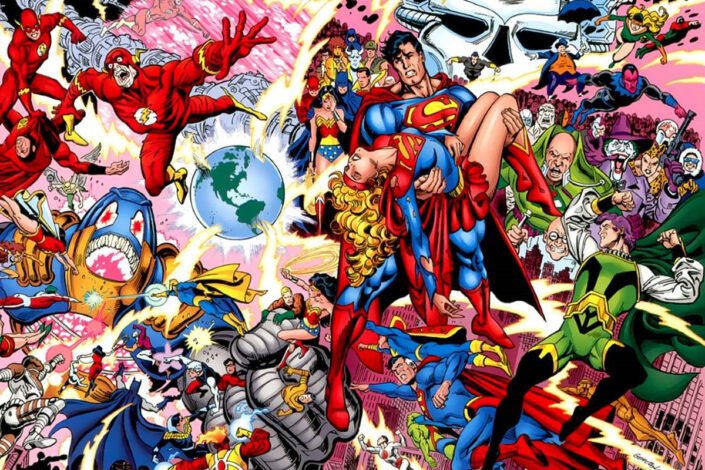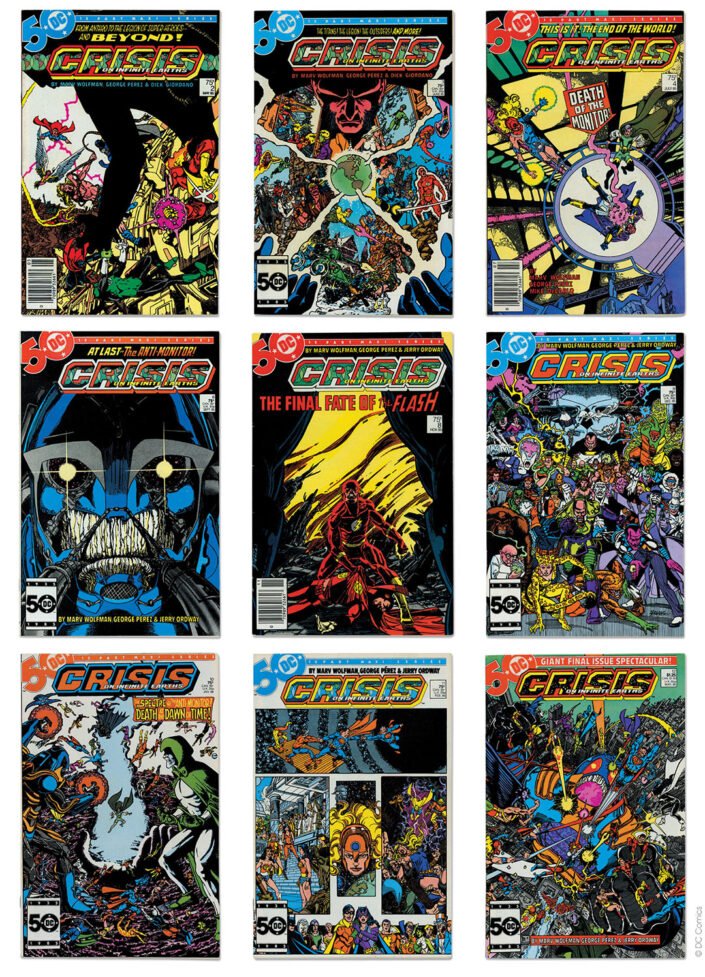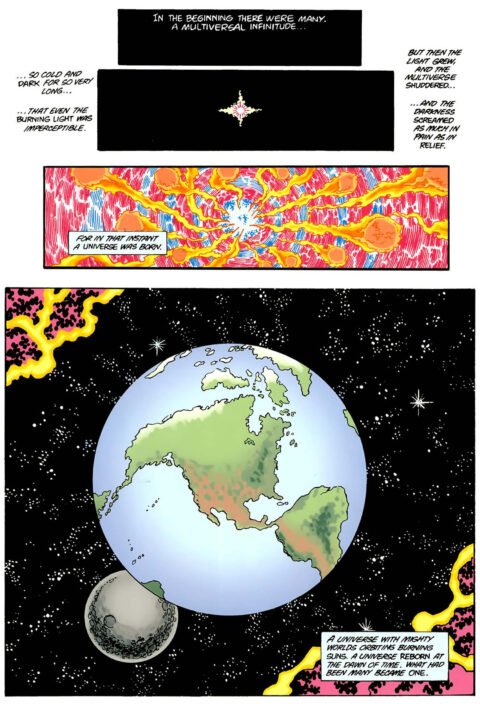
Imagine the whole universe is in peril. I mean Universes! An unprecedented menace is coming, worlds are being annihilated, and nothing and nobody can’t stop it, except maybe if all the superheroes and supervillains unite. No, it’s not the pitch for next week’s major comics crossover event at Marvel or DC, because it’s 1985 and nothing as ambitious and of that scale has ever happened before.
It was Crisis on Infinite Earths, the story that changed the DC Universe and the American comic book industry forever.
The Origins of DC’s Crisis
Crisis on Infinite Earths was not the first maxi-series that united a lot of heroes into one crossover event. In 1984, Marvel’s Secret Wars had been a success, taking popular heroes onto another planet to fight supervillains. Spider-Man’s black costume was even introduced at that time and became an instant sensation. But once the battle ended, everybody came back to their usual crime-fighting business on Earth. As a matter of fact, the way it was published, they were back even before the end.
The commercial success of Secret Wars continued to push Marvel further in front of DC. The sales gap between the big two companies was widening. The flagship titles failed to generate enthusiasm and, for some reason, it was decided that part of the reader’s lost of interest was to blame on the complexity of the DC Universe. It was just too hard to follow for casual readers. There were too many versions of Superman, Batman, and Wonder Woman.
The multiverse was born in 1961 in the classic “Flash of Two Worlds!” story by Carmine Infantino and Gardner Fox. Two decades later, it was not just Earth-One and Earth-Two. DC’s alternate universes had multiplied. It felt necessary to simplify everything.
It was not an idea that came up suddenly. In 1980, Marv Wolfman was writing the Green Lantern series and received a letter from a fan saying they should “fix up DC continuity.” Wolfman agreed and sold the whole idea to DC in a few days. The event was publicly announced during a comic book convention in New York in 1981.
The History of Crisis on Infinite Earths
Growing up in the 1960s, Marv Wolfman was familiar with the regular team-ups between the Justice League of America from Earth-One and the Justice Society of America from Earth-Two. He loved them and wanted an even bigger team-up, one that would include every single one of DC’s Super-Heroes. His love for the British TV Show The Prisoner led him to think that a similar format, one limited series with a beginning, a middle, and an end, would be perfect for his story.
Back then, long ongoing series were privileged as new readers didn’t trust that new ones were going to stay. You didn’t have so many issue #1 during the 1970s. With the introduction of the Direct Market, new comic book shops appeared, fan culture evolved, and new fans liked new books.
So, in 1981, when Wolfman introduced his concept of a maxi-series that would destroy the multiverse to reset the continuity, DC Comics was ready to green-light the project.
It turned out that the idea that DC’s continuity was convoluted was true. Researching the stories and characters in preparation for the book took a long time–researcher Paul Sanderson was brought in to read every DC Comic published since 1935 and take notes. At some point, the project was pushed to 1985 to coincide with DC Comics’ 50th anniversary. It was fitting.
But the seeds were planted before that. When Wolfman got the official green light for Crisis on Infinite Earths, he started injecting elements of his story into the continuity. In New Teen Titans #21 (1982), the mysterious cosmic being known as The Monitor was introduced. Two years later, he made a comeback doing what we later learn was tests on the superheroes to know which ones were better suited for his plan to defeat the Anti-Monitor.
“When George and I began CRISIS we promised that worlds would live, worlds would die, and the DC Universe would never be the same.”
–Marv Wolfman. “Crisis on Infinite Earths” (1998)
Wolfman’s New Teen Titans collaborator George Pérez was recruited to illustrate the book. For him, it was a dream come true “I’d always wanted to draw every character in the DC Universe” (George Pérez: Storyteller). For him, drawing all those characters was not the hard part. In fact, he had difficulties stopping himself from adding more characters. However, he needed to do a lot of reference work as he was not familiar with every hero and villain of that time.
“I knew that if the DC Universe wasn’t going to be the same again, this was going to be my one shot to draw some characters I would never have an opportunity to draw again afterwards. I got to draw the Metal Men. I got to draw Dolphin. I snuck in the Secret Six — who even remembers the Secret Six? I drew characters I had never heard of before. It was a lot of fun.”
–George Pérez. “George Pérez: Storyteller”
It was a lot of work, including for inkers. Dick Giordano was the first to ink Pérez’s work. After three issues, he was replaced by Mike DeCarlo for issue #4, then Jerry Ordway finished the series.
Marv Wolfman had to face a different type of challenge as DC’s editorial staff was not completely on board with the idea. As it was the first time, no one had worked on a company-wide crossover event and some editors simply didn’t understand the concept. Workplace politics took time away from writing and George Pérez had to help and became co-plotter.
Originally planned for 10 issues, Crisis on Infinite Earths got 12 instead to fit everything that was needed to achieve the required reset of the DC Universe. Characters died. World died. One Earth lived, and a lot of superheroes survived.
The Complicated Legacy of Crisis on Infinite Earths
In 2025, Crisis on Infinite Earths is going to celebrate its 40th anniversary–and DC Comics its 90th. It is known as the event that changed the DC universe as there is a pre-Crisis and a post-Crisis in the history books. But things didn’t work as smoothly as it seemed.
For Marv Wolfman, the original idea was to relaunch every DC comic with a character featured in the event with an issue #1. A Post-Crisis clean slate. However, the conflicts with the editorial staff complicated things as the company refused to force the relaunch upon its creators. Some of the titles continued for a while as if nothing happened. Others relaunched quickly. Overall, it undermined the impact of the Crisis.
Crisis on Infinite Earths succeeded at bringing back readers and enough was done to simplify the continuity for a while–after the event, Wolfman and Pérez created The History of the DC Universe, a guide to the new DC Universe. Nevertheless, DC needed to clean up its continuity, but when the time came to go all the way, the company didn’t push far enough.
Since then, other tentatives have been made to fix things. In fact, 8 years after the Crisis ended, in 1994, DC did a second smaller reboot with Zero Hour. More came. Not all Crisis intended to correct course, but some led to other reboots–these gave us the New 52, Rebirth, and Infinite Frontier. None of them completely reset the DC continuity once and for all.
After the commercial success of Crisis on Infinite Earths, Marvel also progressively went bigger with its events. In fact, company-wide crossovers are now the norm. Marvel and DC published at least one of them a year. They often come with some character’s death and end with the launch of new series or relaunch of old ones.
We may now jump from Crisis to Crisis, but when you talk about The Crisis, only one still comes to mind: Crisis on Infinite Earths!
Complement this article with a reading of the famous Crisis on Infinite Earths and don’t miss an issue with our Reading List!


